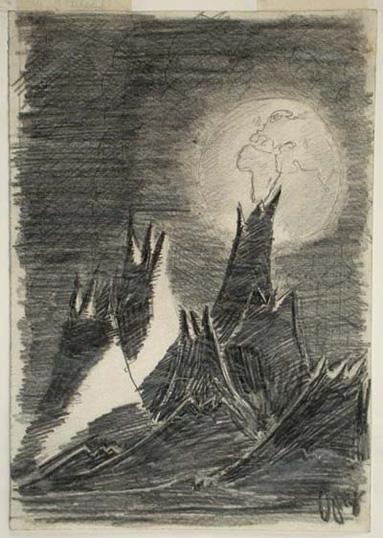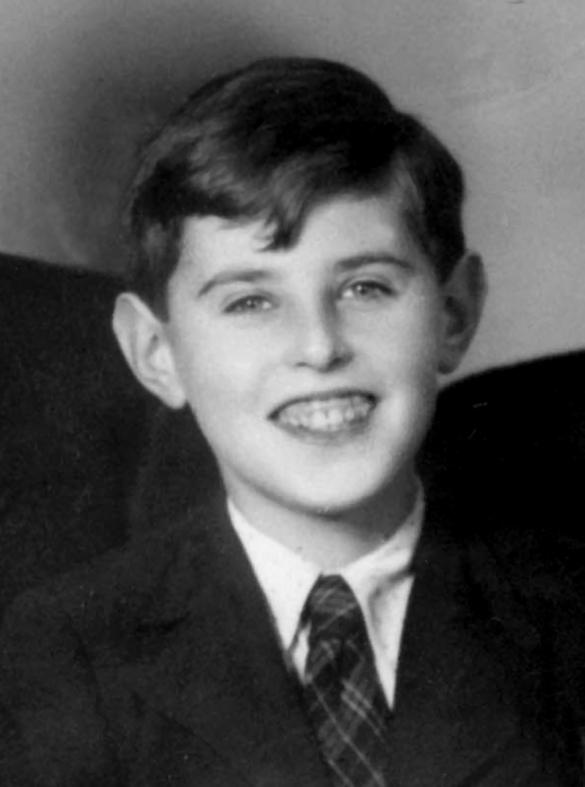05 February 2003
Yad Vashem, The Holocaust Martyrs' and Heroes' Remembrance Authority, has prepared a special exhibit to honor the memory of Israeli astronaut Col. Ilan Ramon. The exhibit is located in the Yad Vashem's Holocaust History Museum. Prior to his flight, Ramon contacted Yad Vashem, asking to take a relic from the Holocaust with him on his shuttle mission. Yad Vashem staff searched through its extensive collections to find something personally relevant to Ramon - whose mother and grandmother survived Auschwitz. “When we came upon Petr Ginz’s Moon Landscape, we knew that we had found a match,” reflected Avner Shalev, Chairman of the Yad Vashem Directorate. “Not only was Ginz murdered in Auschwitz (at the age of 16), but his sketch reflects his vision of how the earth would look from the moon. Ginz was also a talented author who, like Ramon, demonstrated an affinity for the sciences.”
“Ramon’s choice to take the drawing (and other artifacts) with him shows the significant role the Holocaust played in his identity as a Jew and as an Israeli,” says Shalev. Ramon took a replica of the drawing, produced according to NASA specifications. The original Moon Landscape is featured in a showcase in Yad Vashem’s Holocaust History Museum that was prepared in honor of Ramon and Ginz. Also featured are photos of Ramon and Ginz; and from Yad Vashem’s Hall of Names the Page of Testimony for Petr Ginz that was filled out by his sister; and a Page of Testimony filled out by Ramon’s mother for a family member. The items featured in the exhibit: Moon Landscape , the pictures of Petr Ginz and Ilan Ramon, and Pages of Testimony.
For more background on Moon Landscape, see below.
Holocaust-era Art from Yad Vashem’s Collection sent into space with Israeli Astronaut
Israel’s first-ever astronaut, Colonel Ilan Ramon,was launched into space on January 16, 2003 with Holocaust-era art from Yad Vashem’s Art Museum.
Ilan Ramon, a colonel in the Israeli Air Force, contacted Yad Vashem requesting a Holocaust related item to take with him on his launch into space on the shuttle Columbia, due to the significance of the Holocaust to him as a Jew and as an Israeli. On a personal level, the Holocaust is even more meaningful to Ramon as his mother is an Auschwitz survivor, and his grandfather and other members of his family perished in the death camps.
Yad Vashem chose “Moon Landscape”, created by Petr Ginz, a 14-year-old Jewish boy, during his incarceration in the Theresienstadt ghetto. Petr Ginz was multi-talented and had, at a young age, already written stories, articles and poetry, and continued to do so after being sent to the ghetto in 1942. During his incarceration Ginz traveled to places near and far within the depths of his imagination, and with great longing, he visited Prague, the city of his birth, in a poem written from behind the ghetto walls. In 1944 Ginz was killed in Auschwitz.
The moon landscape depicted in Petr Ginz’s drawing attests to his aspiration to reach a place from where the earth, which threatened his life, could be seen from a secure range. Even more so, the picture reveals a young man who, in addition to his other talents, was both a researcher and scientist full of optimism that science precedes all and would ultimately bring a remedy for humanity.
Speaking to the New York-based American Society for Yad Vashem from the Houston, Texas Space Centre where he is in training, Ilan Ramon said, “I feel that my journey fulfills the dream of Petr Ginz 58 years on. A dream that is ultimate proof of the greatness of the soul of a boy imprisoned within the ghetto walls, the walls of which could not conquer his spirit. Ginz’s drawings, stored at Yad Vashem, are a testimony to the triumph of the spirit."
“Moon Landscape” connects the dream of one Jewish boy who is a symbol of the talent lost in the Holocaust, to the journey of one Jewish astronaut, who is a symbol of our revival.



